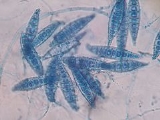
Microsporum
Encyclopedia
Microsporum is a genus of fungi that causes tinea capitis, tinea corpus, ringworm, and other dermatophytoses. Microsporum forms both macroconidia and microconidia on short conidiophores. Macroconidia are hyaline
, multiseptate, variable in form, fusiform, spindle-shaped to obovate, ranging from 7 to 20 by 30 to 160 um in size, with thin- or thick-echinulate
to verrucose cell walls. Their shape, size and cell wall features are important characteristics for species identification. Microconidia are hyaline, single-celled, pyriform to clavate, smooth-walled, 2.5 to 3.5 by 4 to 7 um in size and are not diagnostic for any one species.
The separation of this genus from Trichophyton
is essentially based on the roughness of the macroconidial cell wall, although in practice this may sometimes be difficult to observe. Seventeen species of Microsporum have been described, however only the more common species are included in these descriptions.
Hyaline
The term hyaline denotes a substance with a glass-like appearance.-Histopathology:In histopathological medical usage, a hyaline substance appears glassy and pink after being stained with haematoxylin and eosin — usually it is an acellular, proteinaceous material...
, multiseptate, variable in form, fusiform, spindle-shaped to obovate, ranging from 7 to 20 by 30 to 160 um in size, with thin- or thick-echinulate
Echinulate
Echinulate is an adjective describing the spiny, or "spiky" nature of some spores found in plants and fungi; an example is the auxiliary cell. The words derives from the same root as the prefix echino, meaning that the shape is similar to the porcupine ....
to verrucose cell walls. Their shape, size and cell wall features are important characteristics for species identification. Microconidia are hyaline, single-celled, pyriform to clavate, smooth-walled, 2.5 to 3.5 by 4 to 7 um in size and are not diagnostic for any one species.
The separation of this genus from Trichophyton
Trichophyton
The fungus genus Trichophyton is characterized by the development of both smooth-walled macro- and microconidia. Macroconidia are mostly borne laterally directly on the hyphae or on short pedicels, and are thin- or thick-walled, clavate to fusiform, and range from 4 to 8 by 8 to 50 um in size....
is essentially based on the roughness of the macroconidial cell wall, although in practice this may sometimes be difficult to observe. Seventeen species of Microsporum have been described, however only the more common species are included in these descriptions.
Species
- Microsporum amazonicum
- Microsporum audouiniiMicrosporum audouiniiMicrosporum audouinii is a species of fungus in the genus Microsporum.It is associated with the disease known as tinea, an infection of keratinized tissues like epidermis, hair and nails...
- Microsporum boullardii
- Microsporum canisMicrosporum canisMicrosporum canis is an organism that can cause tinea capitis in humans, and simple ringworm in pets. Despite its name, its major reservoir in companion animals is the domestic cat and dog.It is closely related to other dermatophytes....
- Microsporum canisMicrosporum canisMicrosporum canis is an organism that can cause tinea capitis in humans, and simple ringworm in pets. Despite its name, its major reservoir in companion animals is the domestic cat and dog.It is closely related to other dermatophytes....
var. distortum - Microsporum cookei
- Microsporum distortum
- Microsporum duboisii
- Microsporum equinum
- Microsporum ferrugineum
- Microsporum fulvum
- Microsporum gallinae
- Microsporum gypseum
- Microsporum langeronii
- Microsporum nanum
- Microsporum persicolor
- Microsporum praecox
- Microsporum ripariae
- Microsporum rivalieri

